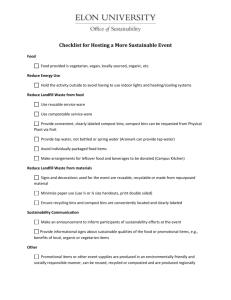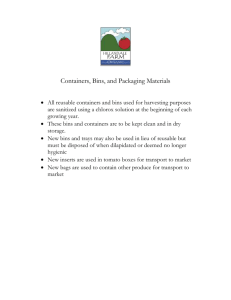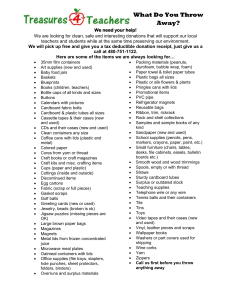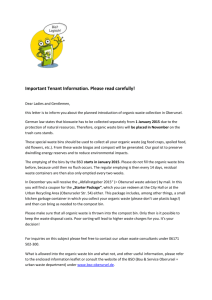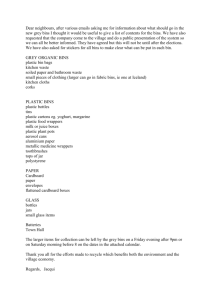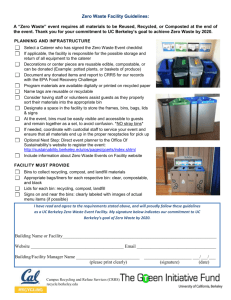Zero Waste - Association for the Advancement of Sustainability in
advertisement
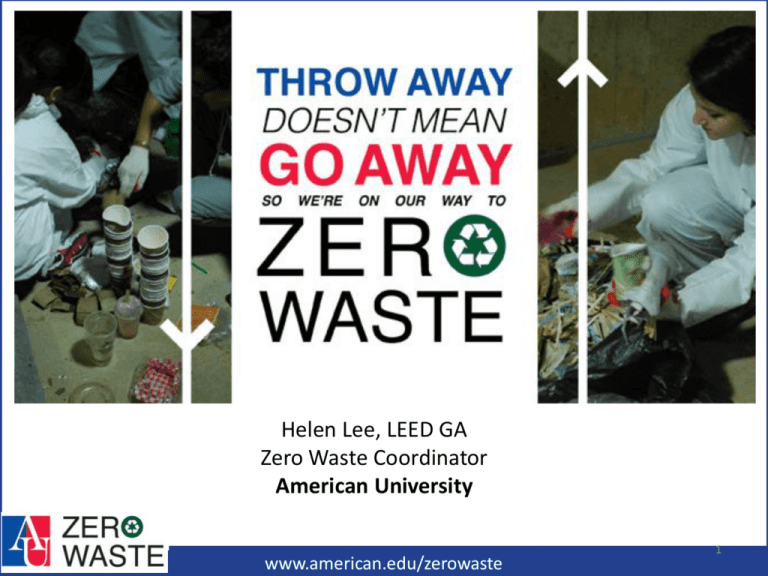
Helen Lee, LEED GA Zero Waste Coordinator American University www.american.edu/zerowaste 1 What We Will Discuss Today • What is AU’s zero waste goal? • How do we get to zero? Understand by auditing • Steps AU has taken to get closer to Zero Waste – – – – – Campus-wide organics collection Review our containers, placement & collection Improving exterior collection Housekeeping training What else can we divert? • Next steps – “on our way to zero waste” 2 What is Zero Waste? “Zero Waste is a goal that is ethical, economical, efficient and visionary, to guide people in changing their lifestyles and practices to emulate sustainable natural cycles, where all discarded materials are designed to become resources for others to use.” Zero Waste Alliance International AU’s Commitment “The university shall strive to reach zero waste to landfill and incineration by 2020.” AU’s Zero Waste Policy: http://www.american.edu/loader.cfm?csModule=security/getfile&pageid=2011196 4 AU’s Sustainability Commitments LEED SITES STARS ACUPCC Certifying 25 buildings 2 Star SITES Pilot Certified Gold rated University Climate Neutrality by 2020 5 Background • • • • • • • • Located in Northwest Washington D.C. 86 acre campus 12,000 students (half undergrad, half grad) 3700 – on campus students 2700 staff/faculty Total Population around 15,000 No football stadium No medical complex 6 Background • President Neil Kerwin signed the Zero Waste Policy in January 2010 • Zero Waste Coordinator was hired 2012 – July 31, 2013, reuse, recycle compost 50% waste – December 2015, reduce solid waste by 10% and divert 90% from landfills and incineration – December 2020, reduce additional 10% and send zero waste to landfill and incineration 7 How do we get to zero? What are we throwing away? 8 Waste Audits 9 Total Waste Summary for the Library (Recycling Bins + Landfill Bins) Clothes Wood 0.01% 0.02% Trash 12.49% White Paper 16.29% Tissue Paper 0.37% Newspaper 0.91% Other Paper 0.53% Food Waste/ Compostable Items 42% Flat Cardboard Packaging 15.69% Glass 2.55% Aluminum 0.97% Plastics 14.96% 10 AU Waste Stream Organics • Chopsticks • Paper Towels • Coffee Grounds • Soiled Cardboard • Food Waste • Tea Bags • Napkins • Wet paper Recyclables • Metals • Plastics • Glass 45% = Compostable 45% Recyclable • Mixed Paper • Dry Cardboard • Paperboard Trash Chip Bags Candy wrappers Styrofoam www.american.edu/zerowaste 10% Landfill Developing a Campus-wide Organic Waste Collection Program 12 45% of our waste Organic Waste • Carbon Containing • Anything once living! 13 • What is organic waste? – Once living? Organic! • Organic vs. Compost • Daily Pick-up • Green Biodegradable Liners • Lids 14 FAQ & Lessons Learned • Will the bin smell? • Will there be pest problems? • Lids on containers? 15 Internal Review of Infrastructure & Collection Methods Container Design Container Placement Quantity of Containers 16 Dual Stream Separation • Downcycling of paper • Lost quality and value of material • Reduced rebates • Not exact weights 17 Redesigning Waste Bins • Color Coded bins & liners • Bins need to educate and market the zero waste program • Different Lids to accommodate materials • Aesthetically Pleasing • Meet AU graphic requirements • Bins made out of recycled material • Durable and Recyclable MIXED PAPER PLASTIC METAL GLASS ORGANIC LANDFILL 18 Redesigned Containers 19 • Trash • Metal, Plastic, Glass • Paper Cardboard 20 21 Improving Efficiency in Exterior Collection 22 -$ Savings -Higher Rebates -Reduced Transportation Emissions -Accurate Weights -Inspect sorted materials on a daily basis 23 Training 24 How does waste travel? How do we reduce contamination? Purchasing Consumer Housekeeping Pest Control Hauler 25 Essential to Train Housekeeping 26 Waste Diversion Recycle • Mixed Paper • Plastic – Metals – Glass • Cardboard • Scrap Metal • Construction Waste • Vehicle Waste • Electronics • Batteries Reuse Compost • Clothes • Electronics • Furniture • Books • Plastic Bags • Food Waste • Yard Waste • Paper towels COMMODITY WASTE MATERIAL WITH VALUE 27 Next Steps • Reuse & Reduction – improve surplus management • Removal of all classroom containers with signage inside • Installation of collection system outside classroom facilities to encourage participation • Removal of all small desk-side bins in offices • Eliminate or replace 10% with alternatives • Work with manufacturers – go upstream • Sustainability language in contracts We are a very wasteful society • We need to change the culture, we need to educate our future leaders • Everyone has to play part, from manufacturer down to the consumer, from procurement to waste management. 29 Connect with us! zerowaste@american.edu www.american.edu/zerowaste Twitter.com/ZeroWasteAU Facebook.com/ZeroWasteAU Youtube.com/ZeroWasteAU Pintrest.com/ZeroWasteAU 30 Sorting inside Buildings 31 Paper Towel Composting 32 Food Waste Composting 33 34 Scrap metal, Construction Waste, Yard Waste 35 Clothing Donation 36 Plastic Bag Collection 37 E-Waste Recycling 38 Other Recycling 39


